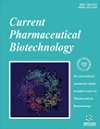- Home
- A-Z Publications
- Current Pharmaceutical Biotechnology
- Previous Issues
- Volume 25, Issue 10, 2024
Current Pharmaceutical Biotechnology - Volume 25, Issue 10, 2024
Volume 25, Issue 10, 2024
-
-
Effects of Antimicrobial Photosensitizers of Photodynamic Therapy (PDT) to Treat Periodontitis
More LessAntimicrobial photodynamic therapy or aPDT is an alternative therapeutic approach in which lasers and different photosensitizing agents are used to eradicate periodontopathic bacteria in periodontitis. Periodontitis is a localized infectious disease caused by periodontopathic bacteria and can destroy bones and tissues surrounding and supporting the teeth. The aPDT system has been shown by in vitro studies to have high bacte Read More
-
-
-
Engineering Platelet Membrane Imitating Nanoparticles for Targeted Therapeutic Delivery
More LessPlatelet Membrane Imitating Nanoparticles (PMINs) is a novel drug delivery system that imitates the structure and functionality of platelet membranes. PMINs imitate surface markers of platelets to target specific cells and transport therapeutic cargo. PMINs are engineered by incorporating the drug into the platelet membrane and encapsulating it in a nanoparticle scaffold. This allows PMINs to circulate in the bl Read More
-
-
-
Postbiotic as Novel Alternative Agent or Adjuvant for the Common Antibiotic Utilized in the Food Industry
More LessAuthors: Sama Sepordeh, Amir M. Jafari, Sara Bazzaz, Amin Abbasi, Ramin Aslani, Sousan Houshmandi and Aziz Homayouni RadBackground: Antibiotic resistance is a serious public health problem as it causes previously manageable diseases to become deadly infections that can cause serious disability or even death. Scientists are creating novel approaches and procedures that are essential for the treatment of infections and limiting the improper use of antibiotics in an effort to counter this rising risk. Objectives: With a focus on the numerous po Read More
-
-
-
miR-488-3p Represses Malignant Behaviors and Facilitates Autophagy of Osteosarcoma Cells by Targeting Neurensin-2
More LessAuthors: Chao Yun, Jincai Zhang and MorigeleObjectives: Osteosarcoma (OS) is a primary bone sarcoma that primarily affects children and adolescents and poses significant challenges in terms of treatment. microRNAs (miRNAs) have been implicated in OS cell growth and regulation. This study sought to investigate the role of hsa-miR-488-3p in autophagy and apoptosis of OS cells. Methods: The expression of miR-488-3p was examined in normal human osteoblasts and OS Read More
-
-
-
Protective Effect of Tertiary Butylhydroquinone against Obesity-induced Skeletal Muscle Pathology in Post-weaning High Fat Diet Fed Rats
More LessBy Le ZhangBackground: Obesity deleteriously affects skeletal muscle functionality starting from infancy to adulthood, leading to dysfunctional skeletal muscle. Objectives: This study, therefore, evaluated the protective action of tert-butylhydroquinone (tBHQ) against obesity-induced skeletal muscle pathology in high-fat diet (HFD) fed rats. Methods: Twenty post-weaning male albino rats were randomized into four groups of five rats e Read More
-
-
-
Therapeutic Path to Triple Knockout: Investigating the Pan-inhibitory Mechanisms of AKT, CDK9, and TNKS2 by a Novel 2-phenylquinazolinone Derivative in Cancer Therapy- An In-silico Investigation Therapy
More LessBackground: Blocking the oncogenic Wnt//β-catenin pathway has of late been investigated as a viable therapeutic approach in the treatment of cancer. This involves the multi-targeting of certain members of the tankyrase-kinase family; Tankyrase 2 (TNKS2), Protein Kinase B (AKT), and Cyclin- Dependent Kinase 9 (CDK9), which propagate the oncogenic Wnt/β-catenin signalling pathway. Methods: During a recent investig Read More
-
-
-
Acute Toxicity, Anti-diabetic, and Anti-cancerous Potential of Trillium Govanianum-conjugated Silver Nanoparticles in Balb/c Mice
More LessAuthors: Nazia Gulzar, Saiqa Andleeb, Abida Raza, Shaukat Ali, Iram Liaqat, Sadaf A. Raja, Nazish Mazhar Ali, Rida Khan and Uzma Azeem AwanBackground: The current study aimed to develop an economic plant-based therapeutic agent to improve the treatment strategies for diseases at the nano-scale because Cancer and Diabetes mellitus are major concerns in developing countries. Therefore, in vitro and in vivo antidiabetic and anti-cancerous activities of Trillium govanianum conjugated silver nanoparticles were assessed. Methods: In the current study synthesis Read More
-
-
-
Anticancer Effect of Dihydroartemisinin via Dual Control of ROS-induced Apoptosis and Protective Autophagy in Prostate Cancer 22Rv1 Cells
More LessAuthors: Jiaxin Yang, Tong Xia, Sijie Zhou, Sihao Liu, Tingyu Pan, Ying Li and Ziguo LuoBackground: Dihydroartemisinin (DHA), a natural agent, exhibits potent anticancer activity. However, its biological activity on prostate cancer (PCa) 22Rv1 cells has not been previously investigated. Objectives: In this study, we demonstrate that DHA induces anticancer effects through the induction of apoptosis and autophagy. Methods: Cell viability and proliferation rate were assessed using the CCK-8 assay and cell clone f Read More
-
-
-
Biosynthesized Silver Nanoparticles from Cyperus conglomeratus Root Extract Inhibit Osteogenic Differentiation of Immortalized Mesenchymal Stromal Cells
More LessBackground: Silver nanoparticles (AgNPs) are a focus of huge interest in biological research, including stem cell research. AgNPs synthesized using Cyperus conglomeratus root extract have been previously reported but their effects on mesenchymal stromal cells have yet to be investigated. Objectives: The aim of this study is to investigate the effects of C. conglomeratus-derived AgNPs on adipogenesis and osteogenesis of m Read More
-
Volumes & issues
-
Volume 26 (2025)
-
Volume 25 (2024)
-
Volume 24 (2023)
-
Volume 23 (2022)
-
Volume 22 (2021)
-
Volume 21 (2020)
-
Volume 20 (2019)
-
Volume 19 (2018)
-
Volume 18 (2017)
-
Volume 17 (2016)
-
Volume 16 (2015)
-
Volume 15 (2014)
-
Volume 14 (2013)
-
Volume 13 (2012)
-
Volume 12 (2011)
-
Volume 11 (2010)
-
Volume 10 (2009)
-
Volume 9 (2008)
-
Volume 8 (2007)
-
Volume 7 (2006)
-
Volume 6 (2005)
-
Volume 5 (2004)
-
Volume 4 (2003)
-
Volume 3 (2002)
-
Volume 2 (2001)
-
Volume 1 (2000)
Most Read This Month
Article
content/journals/cpb
Journal
10
5
false
en


